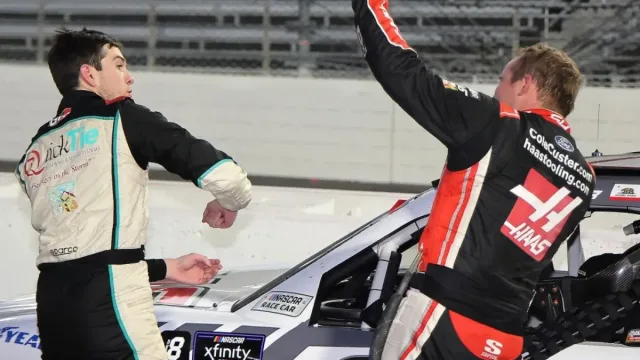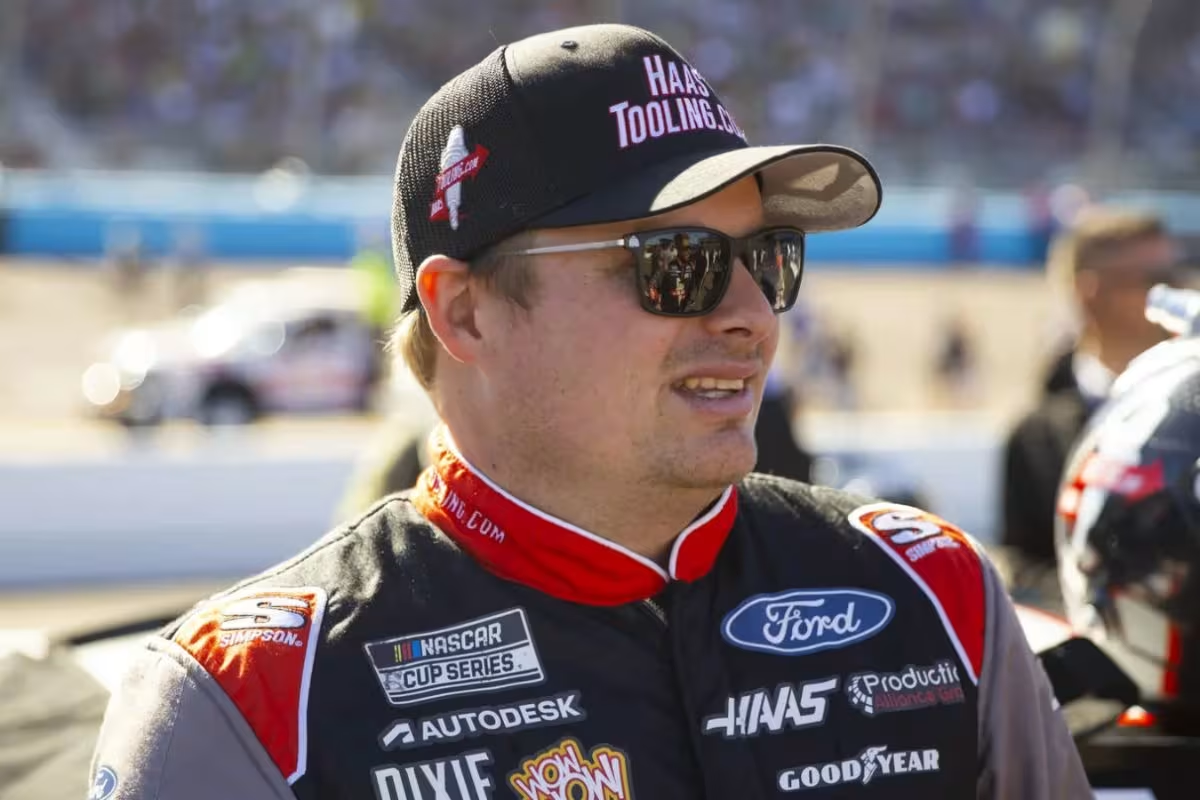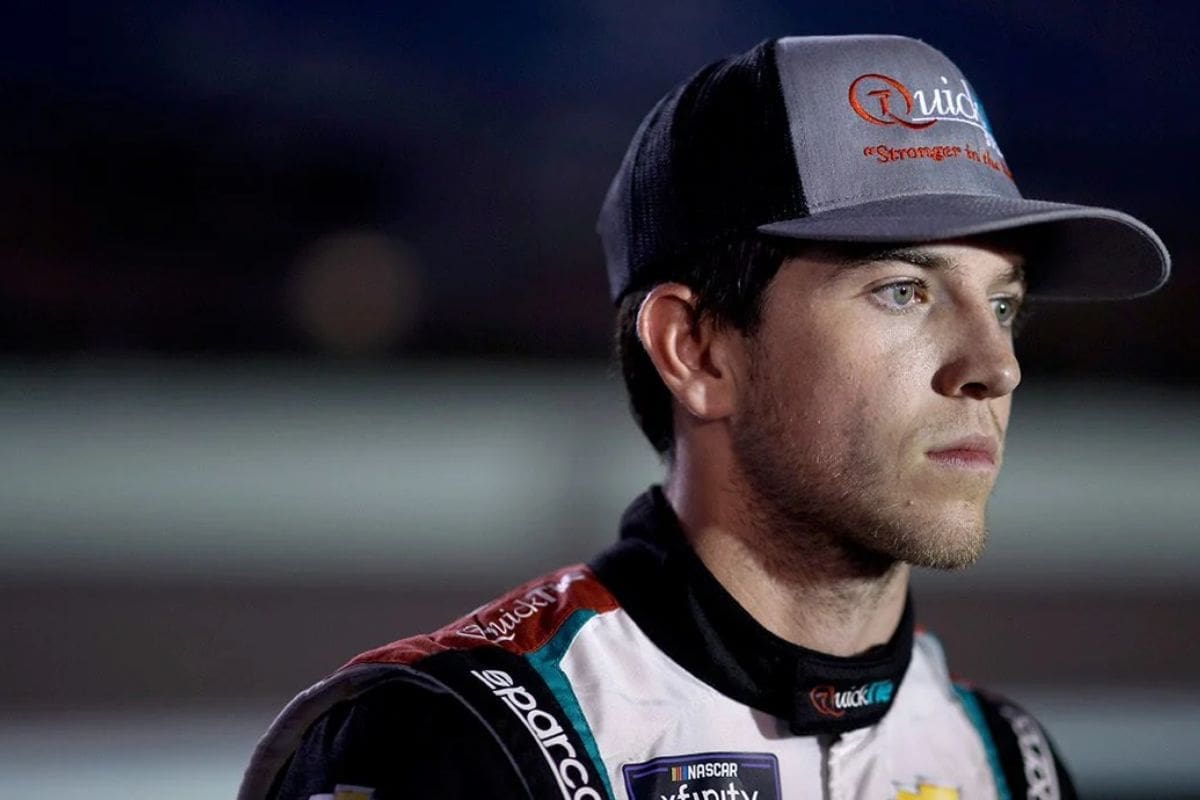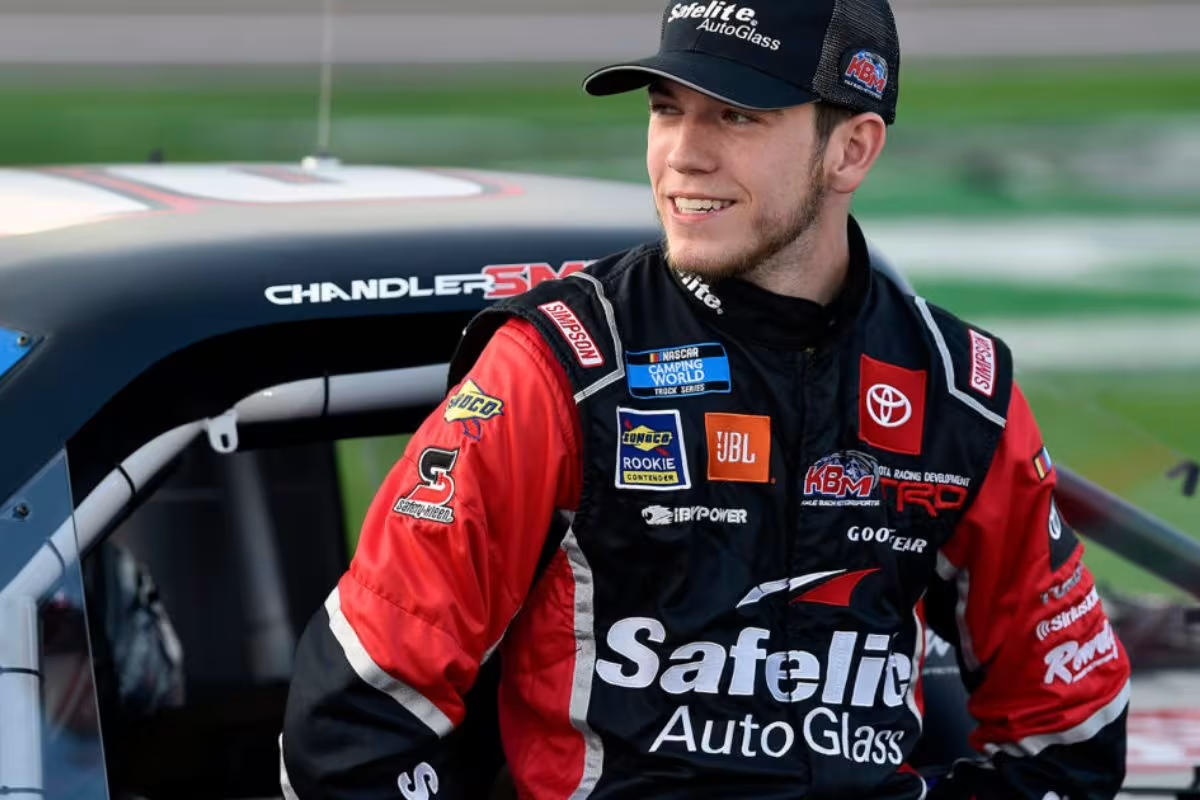Cole Custer Gets Fiery Revenge on Chandler Smith: At Martinsville, Cole Custer confronted Chandler Smith in a dramatic confrontation that highlighted the fierce dynamics of competitive racing. Tensions erupted when Chandler Smith’s aggressive bump led to Cole Custer spinning, prompting a retaliatory move during the restart. Despite the chaos, Cole Custer finished fourth, just behind Chandler Smith, who managed a second-place finish.
This encounter demonstrates the psychological complexities underpinning their rivalry, as both drivers navigate the pressures of NASCAR championship aspirations. With Chandler Smith’s career path in question, their clash may have far-reaching implications.
Key Highlights
- Cole Custer and Chandler Smith’s rivalry intensified during the Martinsville race, culminating in a significant on-track clash.
- Smith’s initial contact with Custer caused a spin, leading to a caution flag and heightened tensions between the drivers.
- Custer retaliated during the restart, impacting their positions and further escalating the competitive dynamic.
- Post-race interactions indicated unresolved issues, highlighting the psychological aspects of their rivalry in racing.
- The confrontation at Martinsville served as a crucial moment for both drivers, with implications for their future racing careers.
Tension Builds at Martinsville Ahead of NASCAR Championship Decider
As the NASCAR championship decider looms, the atmosphere at Martinsville Speedway crackles with noticeable tension, akin to a pressure cooker ready to explode. This iconic track, known for its short, flat layout, often serves as a crucible for fierce competition, where every point counts and emotions run high.
With the stakes raised as the penultimate race of the season, competitors are acutely aware that their NASCAR championship aspirations hinge upon their performance in this high-pressure environment.
Recent events in both the NASCAR Truck Series and NASCAR Xfinity Series demonstrate the unstable nature of racing at Martinsville. Christian Eckes’s aggressive maneuver to bump Tylor Gray out of contention exemplified the cutthroat mentality that often permeates the grid.
Likewise, the unfolding drama between Chandler Smith and Cole Custer highlighted the delicate balance between desperation and strategy. With Smith in a must-win situation, his willingness to engage in aggressive tactics against the defending champion ultimately proved detrimental, leading to his own elimination from championship contention.
A bump-and-run moves @CSmith_Racing into second as the yellow comes out for @BrandonJonesRac.
Less than 30 to go at @MartinsvilleSwy! #NASCARPlayoffs pic.twitter.com/Bi5iyRudHf
— NASCAR Xfinity (@NASCAR_Xfinity) November 2, 2024
In this charged atmosphere, drivers must navigate not just their competitors, but also the fine line between calculated aggression and reckless abandon. The tension builds not only from the imminent championship implications but also from the personal rivalries that can ignite in an instant.
The On-Track Clash Between Custer and Smith
The on-track clash between Cole Custer and Chandler Smith illustrated the fierce dynamics of short-track racing, where split-second decisions can have lasting repercussions. With 30 laps remaining, Smith, facing a must-win scenario, initiated the contact that sent Custer spinning. This incident not only altered their race trajectories but also ignited a simmering rivalry that would boil over during the restart.
Tempers flare on pit road after the race! #NASCARPlayoffs pic.twitter.com/Iiss8Et2VI
— NASCAR Xfinity (@NASCAR_Xfinity) November 2, 2024
Custer’s response was calculated; he waited for the restart to retaliate, showcasing a tactical mindset during chaos. The following collision not only affected their standings in the race but also highlighted the emotional stakes involved, particularly for Smith, who was already grappling with uncertainty regarding his future in the sport. The aftermath in the pit lane further illustrated the intensity of their rivalry, suggesting that the feud is far from over. Such on-track clashes are a reflection of the high-pressure environment of racing, where every decision is scrutinized, and reputations are forged in the heat of competition.
“I mean obviously he’s not happy at the end of the day he’s put us in the wall a few times this year and his mistakes caught up with him, he used the bumper on me I used the bumper on him. So what comes around goes around in this deal. I’m so proud of this team, we brought everything we had today. Kept us in the fight, maximizing all year. Can’t wait to go to Phoenix now and see what to do.” -cole Custer
Cole Custer’s Take on the On-Track Feud
Cole Custer has made it clear that he believes in the principle of reciprocity regarding racing rivalries. His recent actions on the track exemplify a philosophy that sees actions having consequences, particularly in NASCAR.
“It really made me mad when he put us in the fence on that restart. He’s gonna pay the consequences for that. I’m gonna race him like he races me.”- cole Custer
After a series of on-track incidents with Chandler Smith, Custer articulated his rationale for the fiery retaliation at Martinsville. He stated, “At the end of the day, he’s put us in the wall a few times this year, and his mistakes caught up with him.” This acknowledgment of previous grievances emphasizes Custer’s perspective that racing is not merely a competition of speed but also a complex interplay of respect and retribution.
Custer’s comments reveal a deeper understanding of the psychological dynamics at play in racing. He is not just reacting emotionally to being bumped; he is engaging in a calculated response to a perceived pattern of unfairness.
By asserting, “I used the bumper on him,” Custer reinforces that he is willing to engage in the same aggressive tactics employed by Smith. His assertion that “what comes around goes around“ encapsulates a mindset prevalent among drivers who navigate the fine line between competitive zeal and sportsmanship.
”I think it is what it is at the end of the day, he put us in the wall a few times this year. I felt like he kept us from winning the race at Kansas and he used the bumper on me and I used the bumper on him. I don’t know how we are not even.”
“…He punched me in the face. I can’t even tell if he punched me in the face, it was so soft.” – cole Custer
In a world where rivalries can ignite and escalate quickly, Custer’s approach suggests a commitment to a code of conduct that values mutual respect—or its absence.
"His mistakes caught up with him."@ColeCuster will have a chance to defend his title next weekend in Phoenix after making it on points.
But, the bigger story tonight is the clash with Chandler Smith that could carry over to the Championship race.#NASCAR #NASCARPlayoffs pic.twitter.com/alaximEKin
— NASCAR on TSN (@NASCARonTSN) November 2, 2024
As he looks ahead to Phoenix, it will be intriguing to see how this feud evolves and whether Custer’s philosophy continues to guide his racing strategy.
Chandler Smith Shares His Side of the Story
Chandler Smith’s perspective on the recent on-track tensions with Cole Custer offers a compelling counterpoint to Custer’s rationale for retaliation. While Custer downplayed the incident, Smith revealed a complex emotional landscape driving his actions at Martinsville. The Joe Gibbs Racing driver articulated his escalating frustration, underscoring the high stakes of the race and the urgency of his situation.
Key points from Smith’s account include:
- Frustration and Urgency: Smith felt compelled to act aggressively due to his unstable position in the points standings. With a -28 points deficit, a P3 finish was insufficient, fueling his desperation.
- Waiting for Opportunity: Prior to the caution, Smith asserts he gave Custer ample opportunity, stating, “I gave him five laps before that caution came out.” This highlights his strategy—waiting patiently before resorting to more aggressive maneuvers.
“I was planning to do a lot more than that (punch him), to be completely frank. I was extremely pissed off. I gave him five laps before that caution came out, and beat his bumper off. Never shipped him or anything like that.” – Chandler Smith
- Decisive Action: Ultimately, Smith made the choice to push Custer up the track, believing that Custer’s decision to take the outside lane reflected a lack of respect for their racing dynamics. “He didn’t even give me a chance to make the corner,” Smith noted, illustrating his perception of unfairness in their encounter.
“I finally pushed him up the track and went on our way. But I gave him a chance for five laps before that. Well, I think he was the first guy all day that choose the outside lane from third place so that’s very interesting. He didn’t even give me a chance to make the corner once we got to Turn 1.” – Chandler Smith
Through Smith’s lens, the situation is painted not merely as petty rivalry but rather as a critical tactical decision shaped by competitive pressures. This nuanced insight challenges the simplistic narratives often surrounding racing incidents, inviting deeper reflection on driver psychology.
What’s Next for Chandler Smith?
With the 2025 racing season looming, uncertainty surrounds Chandler Smith‘s future in the sport, raising questions about his next steps following a tumultuous year. As he candidly shared with Fox Sports, Smith faces the reality of potentially stepping away from competitive racing, given that no team has yet offered him a ride for the upcoming season. His admission, which includes the possibility of joining his father’s construction business, highlights the unstable nature of a career that once seemed promising.
Despite his struggles, it is premature to write off the 22-year-old Georgia native. Smith has showcased considerable talent, evidenced by his five wins in the NASCAR Truck Series and three victories in two full seasons of NASCAR Xfinity. These accomplishments suggest that he possesses the skill set necessary for success at higher levels, making his current predicament all the more perplexing.
The market for driver positions is notoriously competitive, especially for those without substantial financial backing. Smith’s acknowledgment that “big pocketbooks” are a prerequisite for available seats highlights the challenges faced by emerging talents who may lack the sponsorship resources to secure rides.
“Well, I don’t have a ride next year, Bob. I could be working for my dad’s construction business and I could be hanging it up at the end of this year. So, that being said, all craps will not be given at Martinsville. It’s not really any seats left open. The only seats left open you gotta bring a big, big pocketbook with you and I don’t have a big pocketbook.” – Chandler Smith
As the season unfolds, Smith must evaluate his options critically. Whether he pursues opportunities in lower-tier series, seeks to align with a team willing to invest in his potential, or considers alternative careers, the decisions he makes in the coming months will fundamentally shape his path in the sport.
News in Brief: Cole Custer Gets Fiery Revenge on Chandler Smith
The recent confrontation between Cole Custer and Chandler Smith at Martinsville exemplifies the intense rivalries that characterize the world of motorsports. This incident not only emphasizes the competitive spirit inherent in racing but also highlights the necessity for drivers to navigate personal tensions while vying for NASCAR championship glory.
As the NASCAR season progresses, the implications of this clash may resonate beyond the track, influencing both drivers’ strategies and dynamics in future races, shaping their respective careers in unpredictable ways.
ALSO READ: Cole Custer Confrontation With Chandler Smith: Denny Hamlin Speaks Out!



